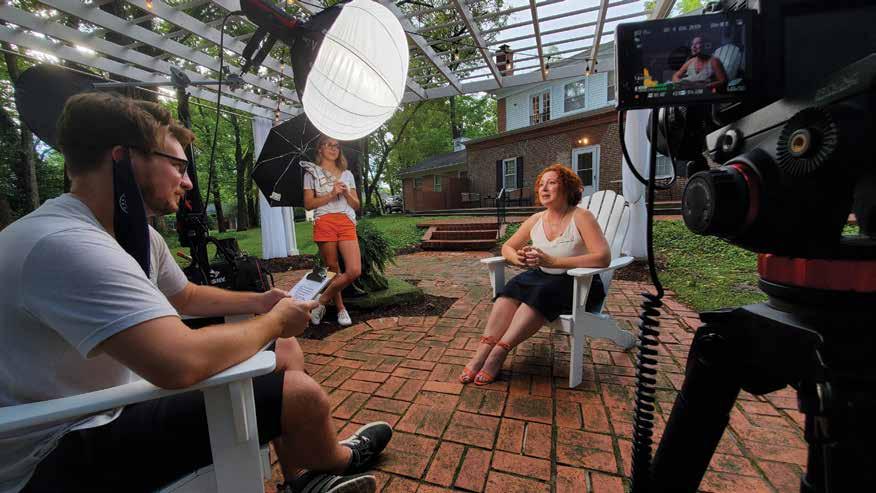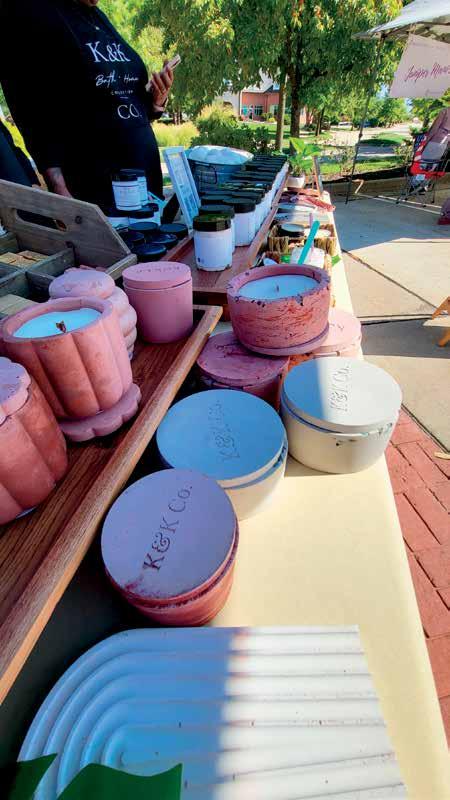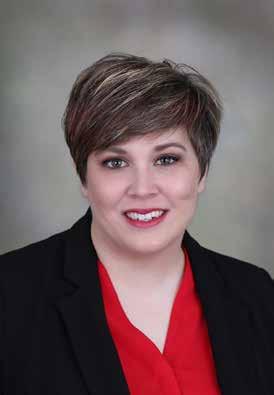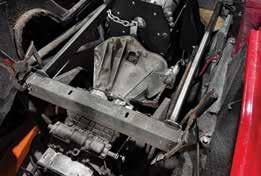






Joe Machens Nissan is proud to announce Samantha Sonnemaker has been named one of Automotive News’ 40 Under 40, representing the brightest young leaders within the industry.



























CBT ’s advisory board is made up of industry leaders and small business owners who help ensure CBT ’s content is relevant to our local business community.

This issue was really fun for me. I enjoyed watching my city friends learn about all the ways agriculture in mid-Missouri impacts all of our lives as we put the issue together. We went from “How in the world are we going to fill the magazine with stories on ag?” to having more than we can use in the printed edition.

I personally love to garden. I mean, LOVE to garden. I love flowers. I love trees. I love vegetables. I love houseplants. Pruning and weeding is a stress reliever for me. I can zone out for hours perfecting my outdoor space and giving my little green buddies the best chance they have to be healthy and to produce flowers or fruit.
My family’s favorite home was a small hobby farm outside of Columbia where we were able to raise chickens, tend a giant garden, fish out of our pond, and have fresh fruit from our orchard. I remember finally figuring out that three-day span in early June when we could harvest our cherry tree after the cherries ripened but before the birds descended on them and completely cleared out the tree in the blink of an eye. I learned to watch for giant black snakes in the hen house while gathering eggs. (I’m still not over that one.) My children helped not only in the raising of chicks but also in the processing of grown chickens for the dinner table. I made grape, peach, and plum jams, pickles, salsa, put up corn, froze chickens, and fish and had a dream homestead. My asparagus patch was one to be envied! While it took quite a bit of work to maintain, the satisfaction I felt from being able to feed my family and friends with things that I had grown myself was immense.

I remember having to work out watering schedules if we didn’t get rain, composting for fertilizer, and praying the late frost wouldn’t kill my peaches and plums for the season. I can’t imagine how that would feel for a real farmer with hundreds and thousands of acres of crops or with herds of animals that need tending. I have nothing but respect for the men and women who battle the elements, rising expenses, and any myriad of things outside of their control to feed our families while maintaining their businesses.

Regardless of how “citified” you are, I hope you enjoy learning how our local agriculture is big business and how it impacts and improves our lives in Columbia.


EDITORIAL
Erica Pefferman, Publisher Erica@COMOBusinessTimes.com
Kim Ambra, Editor-in-Chief Kim@COMOBusinessTimes.com

Jodie Jackson Jr, Digital Editor Jodie@COMOBusinessTimes.com
DESIGN
Kate Morrow, Creative Director Kate@COMOBusinessTimes.com

Jordan Watts, Senior Designer Jordan@COMOBusinessTimes.com
MARKETING
Charles Bruce, Director of Sales Charles@COMOBusinessTimes.com

Scott Callahan, Director of Events Scott@COMOBusinessTimes.com

Amanda Melton, Director of Account Services Amanda@COMOBusinessTimes.com
J.J. Carlson, Director of Web Development jj@comobusinesstimes.com



Sarah Hempelmann, Marketing Representative Sarah@COMOBusinessTimes.com




Becky Roberts, Marketing Representative Becky@COMOBusinessTimes.com
MANAGEMENT
Erica Pefferman, President Erica@COMOBusinessTimes.com


CONTRIBUTING PHOTOGRAPHERS
Jessalynn Cairer, Lana Eklund, Drew Piester
CONTRIBUTING WRITERS
Taylor Ambra, Adonica Coleman, Lauren Sable Freiman, Mat Gass, Lydia Graves, Jodie Jackson Jr, Matt McCormick, Steve Spellman, Brian Toohey
SUBSCRIPTIONS
Magazines are $5.95 an issue. Subscription rate is $54 for 12 issues for one year or $89 for 24 issues for two years. Subscribe at comobusinesstimes.com or by phone. COMO Business Times is published monthly by e COMO Companies.
OUR MISSION STATEMENT COMO Business Times and comobusinesstimes.com strive to be Columbia’s leading source for timely and comprehensive news coverage of the local business community. is publication is dedicated to being the most relevant and useful vehicle for the exchange of information and ideas among Columbia’s business professionals.
Copyright e COMO Companies, 2023 All rights reserved. Reproduction or use of any editorial or graphic content without the express written permission of the publisher is prohibited.

FEATURE
CONSERVATION CASH
Missouri harvests $15 billion a year from conservation programs.
6 ADVISORY BOARD
7 PUBLISHER'S NOTE
11 CLOSER LOOK
12 BRIEFLY IN THE NEWS
14 MOVERS & SHAKERS
21 NONPROFIT SPOTLIGHT
Columbia Center for Urban Agriculture
24 GUEST VOICES
Steve Spellman
31 NEW BUSINESS LICENSES
33 AS SEEN ONLINE
Deep in the Heart of ... Columbia?
36 BUSINESS UPDATE
A-Maize-ing Adventures
39 GUEST VOICES
Brian Toohey
40 P.Y.S.K.
Kenny Mohr
42 GUEST VOICES
Adonica Coleman
43 GUEST VOICES
Matt McCormick
50 WHAT'S GOING UP?
57 GUEST VOICES
Mat Gass
58 BY THE NUMBERS
The Future is Now at CAFNR Agriculture marries technology to produce better crops and livestock.
More than Meets the Eye
MFA's work behind the scenes improves yields for local producers.



Matriarch is a thoughtfully curated shop o ering women’s apparel, accessories, and apothecary goods to bring beauty and simplicity to every day. Owner Claire Nichols says she created Matriarch to bring to life her lifelong dream of having a small business.

Matriarch is mostly an online business, with a small section of merchandise at Hedda in the North Village Arts District. Launching Matriarch in March of this year, Nichols says she has already learned so much along the way and has felt the love and support from the community.
“My hope for Matriarch is to bring a shopping experience to Columbia that inspires people to bring a little beauty to every day, whether that’s throwing on clothing that makes you feel con dent and put-together or lighting a candle for some calm in your home,” Nichols continues. “I also hope to inspire people to consume consciously and intentionally. We live in a time where we can get anything we want instantly, and it is important to me to cultivate a shop with well-made pieces that will last for years.”
636-293-5119
ShopMatriarch.com
Owner and creative director, Patricia Mayele, desired to combine her passion for event planning with her skills in project management to express her creativity through luxury events in the mid-Missouri area. Mayele Design & Events aims to provide an opulent experience for its clients.

“We understand the value of gathering with loved ones and want to alleviate the stress in planning and executing the intricate details so our clients can enjoy quality time with their guests and create long-lasting, impactful memories,” Mayele says. e services vary from full event management to event designs and tablescapes. e business specializes in intimate events such as proposals, baby showers, and luxury picnics, to name a few.
“In gathering, beautiful memories can be created,” Mayele adds, “and we want to be the team that helps to create that atmosphere that sparks those beautiful moments that last a lifetime.”
660-858-8137
MayeleEvents.com
e Clean Re ll, located on the south side of town o Buttonwood Drive, is Columbia’s rst locally owned, fullservice, zero-waste re ll shop. e Clean Re ll hosted its grand opening in June, with a portion of proceeds going to Missouri River Relief.

“ e Clean Re ll’s mission overlaps with Missouri River Relief’s mission,” says owner Leah Christian. “Reducing plastic waste is an important part of protecting Missouri’s waterways and we are excited to provide funds to an organization that educates our community about natural resource stewardship.”
How does it work? It’s simple: Simply take your own container or purchase one of theirs. Weigh the empty container, and then ll it with the product of your choice. Available products range from laundry care and dish care to hand soaps and cleaning supplies, and much more. According to the shop’s website, e Clean Re ll has kept 3,535 bottles from the land ll since opening in February.
573-355-1283
3601 Buttonwood Drive, Suite C
TheCleanRefill.co CBT
Les Dames d’Esco er International (LDEI), an international nonpro t organization of women leaders who work together to achieve excellence in the elds of food, beverage, and hospitality, announced Nina Mukerjee Furstenau as the winner of the 2023 Women of Purpose Award presented in partnership with YETI.

e organization bestows the Women of Purpose Award biannually to a member of LDEI who has made a positive impact in a local or global community, incorporating the important and complex realms of global sustainability, food justice, and public health. Furstenau is a journalist, author, and editor of the Foodstory book series for the University of Iowa Press. She is the author of multiple books, including Biting rough the Skin: An Indian Kitchen in America’s Heartland, which won the MFK Fisher Book Award.
OATS Transit’s Mid-Mo Region
O ce in Columbia announced that it stopped accepting cash payments on their buses e ective July 1. e areas a ected by the change include Audrain, Boone, Callaway, Camden, Cole, Cooper, Gasconade, Howard, Laclede, Maries, Miller, Moniteau, Morgan, Osage, and Pulaski counties in Missouri.
As of July 2023, Mid-Mo Region drivers no longer handle cash payments from riders. Instead, riders can add funds to their account in advance, and fares will be withdrawn each time a rider boards the bus. Riders can call 888-875-6287 to add funds to their account, which requires a minimum of $10 each time. Riders can also send personal checks, money orders, or a cashier’s check by mail prior to riding the bus.
Additionally, fares for all general public riders will be standardized at $2 per one-way ride regardless of origin or destination. e change is necessary to ensure faster loading times, safety of drivers, and convenience for OATS riders. Rider fares help maintain current levels of service and directly impact the company’s operating budget.
Columbia College recently earned a 10-year renewal of its accreditation from the Higher Learning Commission, with its next rea rmation scheduled for 203233. A team of HLC peer reviewers
visited the college this past spring for a comprehensive evaluation that included private sessions with faculty, sta , and community members.
e commission is recognized by the United States Department of Education and the Council for Higher Education Accreditation.
“ e high marks given to Columbia College by our accrediting agency serve to a rm the quality of our academic programs and the excellent support services we provide to our students,” said Columbia College President Dr. David Russell. e college met all ve of HLC’s criteria for accreditation without concern.
e criteria include mission; integrity — ethical and responsible conduct; teaching and learning — quality, resources, and support; teaching and learning — evaluation and improvement; and institutional e ectiveness, resources, and planning.
eodora (Dora) Grafakos, a 2023 Rock Bridge High School graduate, placed rst in the SkillsUSA Baking and Pastry Arts national competition for high school students. She trained through the Columbia Area Career Center’s Culinary Arts Program.
Elizabeth (Lizzy) Brown, a 2023 Rock Bridge High School graduate, placed second in the SkillsUSA Culinary Arts national competition. Grafakos is the second student from CACC to win the SkillsUSA National Baking Competition.

SkillsUSA is a United States career and technical student organization
serving more than 395,000 high school, college, and middle school students and professional members enrolled in training programs in trade, technical, and skilled service occupations, including health occupations. More than 6,500 students in 110 contests from most of the 50 states, as well as Guam, the U.S. Virgin Islands, and Puerto Rico participated in the 2023 national convention in Atlanta, Georgia
Boone Health has received the American Heart Association’s Mission: Lifeline® NSTEMI Gold achievement award for its commitment to o ering rapid, research-based care to people experiencing a speci c type of heart attack known as a non-ST elevation myocardial infarction (NSTEMI). It also received the American Heart Association’s Mission: Lifeline STEMI Receiving Center Gold recognition for its commitment to o ering rapid, research-based care to people experiencing an ST elevation myocardial infarction (STEMI), a type of heart attack known to be more severe and dangerous than other types of heart attacks.
Mission: Lifeline is the American Heart Association’s national initiative to advance the system of care for patients with high-risk, time-sensitive disease states, such as heart attacks.
e program helps reduce barriers to prompt treatment for heart attacks — starting from when 911 is called, to EMS transport and continuing through hospital treatment and discharge.
e Mission: Lifeline achievement award is earned by hospitals that demonstrate a commitment to treating patients according to the most up-todate research-based guidelines for heart attack care as outlined by the American Heart Association. CBT
Petty Officer 2nd Class Garret Vincent, a native of Columbia, supports versatile missions while serving at Helicopter Mine Countermeasures Squadron (HM) 14. Vincent joined the Navy six and a half years ago, now serving as an aircrewman.
Members of HM 14 fly and maintain helicopters for the U.S. Navy. Navy helicopters are able to perform many different missions. In general, some of the most common operations include search and rescue, air assaults, medical evacuations, supply transport, and hunting submarines.
Terry Woodcock, MAED, has assumed the position of Truman VA’s Mid-Missouri Fisher House manager and will oversee day-to-day activities related to the new facility once it opens.
Previously, Woodcock served in several leadership positions within the U.S. Department of Defense and Commander, Naval Installations Command. He retired from the U.S. Navy in 2010 after 31 years of honorable service as a Master Chief Petty Officer.
Katie Griffith, Classic director, was honored with the Dorothy Jacob Customer Service Award at the Central Bank of Boone County
(CBBC) Annual Consumer Banking Awards. The award is presented to someone who exemplifies customer service from the heart, a trait exemplified by the late Dorothy Jacob who spent more than 50 years at the bank and was the first female bank officer in Columbia.
“She listens to people, gives financial advice when they ask her for it, knows the names of their children and grandchildren, remembers the little things that endear her to the Classic members,” said Mary Diblasi, vice president of relationship banking.

The U.S. Department of Veterans Affairs (VA) appointed Christopher Myhaver, MHA, FACHE, as medical center director of Harry S. Truman Memorial Veterans’ Hospital.

Prior to joining Truman VA, Myhaver served as interim medical center director of the Veterans Health Care System of the Ozarks in Fayetteville, Arkansas. Some of his other leadership roles include serving as associate director of the Michael E. DeBakey VA Medical Center in Houston and as deputy executive director of business operations and administration within the Veterans Health
Administration Office of Care in the Community.
Ryan Stonecipher, PE, has joined the mechanical/ electrical/plumbing department of Klingner & Associates, P.C. as a senior engineer. Stonecipher has 16 years of experience designing building systems for higher education, pre-K–12, and commercial clients.
He holds professional licensure in Missouri as well as a Bachelor of Science in mechanical engineering from the Georgia Institute of Technology.

River Region Credit Union welcomes Brandon Barnes as its new director of market sales - real estate. Having been in sales for 18 years with a brief two-year stint as a college football coach with Mizzou athletics, Barnes transitioned to the financial industry in 2020.


Devoting time by giving back to his community, Barnes serves as a board member for Coyote Hill and the Citizens Police Review Board, and as committee chair of the outreach community for the Columbia Board of Realtors. He enjoys helping first-time homebuyers or seasoned buyers, educating and coaching them through the home loan process. CBT







The first thing many small businesses do when starting out is create a logo. A strong logo is one of the most important design elements you can have for your business. It’s what your prospects see first. It shows your identity, distinguishes your business from your competition, and you can put it anywhere from water bottles to letterhead. But as your business grows, you need to regularly reflect on your brand and ensure that it continues to reflect who you are and what your mission is. Have your services changed? Has your mission grown from a local focus to a more regional or national footprint? Is a major anniversary milestone on the horizon or does it just no longer represent the essence of who you are anymore? After answering these questions, you may have decided that you are in need of a rebrand but are curious about next steps. Here’s the process our talented artists use for designing brands.
Do Your Research: First and foremost, you must know your brand. What is your brand about? What do you want your brand to say about your business? Define words that resonate with you about your brand. Knowing your brand clearly and concisely is essential in creating a brand that works for your business.
Know Your Ideal Customer: Do they like sleek and modern designs or fun and playful? Do they resonate with a formal tone or are they more relational in nature? Knowing your customer helps create designs that will appeal to them.
ERICA PEFFERMAN President & Owner
Erica Pefferman is the owner and president of COMO Companies, which owns and operates COMO Magazine, COMO Business Times, COMO Marketing, and COMO Tickets. Erica shares her love of Columbia with the people she serves with on a multitude of boards including the Chamber of Commerce. In 2017, Erica was named Outstanding Business Woman of the year and her team was named the Columbia Chamber Of Commerce’s Small Business of the Year.
Curate Inspiration: Once we’ve gotten to know your business, we can start preparing for the design process. The best way to get started is by creating an inspiration board guided by the information from our research. We gather images, typography, colors, and more, that we feel embody your brand. Providing visual references for words like “modern” or “elegant” helps ensure we’re all on the same page moving forward.
Explore the Possibilites: This is when we take the ideas in our brains and turn them into tangible concepts by ideating based on the information and inspiration that has been gathered. We build out different lockups, try out some more off-the-wall concepts, and really play around with all the possibilities to bring your brand to life.
Narrow in on Concepts: Once we have explored the full breadth of possibilities, it’s time to narrow down our designs to the strongest options and build them out into initial concepts to present!
Show Off the Hard Work: It’s time to present our work and the rationale behind our choices. Why did we chose to go with that specific typeface? What are the possibilities of one concept compared to
573.499.1830 | comomarketing.co
another? What limitations or quirks did the designer work through when building out the concepts? This allows us to discuss and receive feedback.
Refine the Design: After the presentation is complete, we refine your chosen concept based on any suggestions or requests that were made.
Build the Brand: Once a final logo concept is decided upon, we build out your visual identity through type pairings, a color palette, and mockups. Mockups help you understand the context in which your brand will appear in the real world — such as on the aforementioned water bottles and letterhead.
Create a Style Guide: It all comes together here! Your style guide will lay out usage instructions for your logo and color palette, define any additional brand assets, and give you guidelines on how to keep your brand identity consistent across all platforms.
A strong brand says a lot about a business. Do you need help refining or refreshing your brand identity? Contact us and we’ll help you build a brand that lasts for you and your business.
Running a business requires a wide variety of skills and in today’s world that includes protecting your business from fraud. Fraud relies on deception for personal or financial gain. This can happen to you personally or your business. There is not just one tactic a fraudster uses, so it can be difficult to spot and avoid; however, there are ways to keep your business safe.
Your employees are your first line of defense when it comes to fraud. It’s important to provide education and resources on the latest fraud and scam tactics. Your customers could fall victim to fraud attacks such as phishing attacks, mail fraud, and wire transfer fraud. Have a plan in place for your employees on how to spot these attacks and report suspicious activity. The Consumer Financial Protection Bureau has great free resources including articles and free webinars to help educate yourself and your employees on the latest schemes. Find them online at consumerfinance.gov.
Additionally, monitor your financial activity closely and regularly to spot anything suspicious. It might feel time consuming, but checking bank statements can help catch suspicious activity early. Pro tip: Set up account alerts in your online banking to stay on top of any activity on your accounts. Getting an instant alert that money has come out of your account from a place you don’t recognize could be a sign you have fraud.

Brad Roling is the Columbia Market President for Mid America Bank. Brad has more than 10 years of banking experience that he uses to help businesses in and around Columbia thrive. When he is not helping your business with its financial needs, Brad is serving the community in a variety of capacities. He is proud to serve on the Ronald McDonald House Mid-Missouri Board of Directors as Treasurer, the Columbia Chamber Foundation Board, and Beta Theta Pi Advisory Board. Brad is a proud Mizzou grad and loves cheering on the Tigers!
If this happens, call your bank immediately to report the transaction and they will advise on next steps to take.
Another great tool to protect your business from fraud is Positive Pay. This service matches the check number, dollar amount, and account number of every check against a list of checks your business has issued. Any check that doesn’t match the list you provide is flagged for you to review before payment. This is just one of many
banking tools you can arm your business with to protect against fraud.

It is important to find a financial institution that values protecting your accounts from fraud. Your bank should have programs in place that help you mitigate fraud and help educate you on ways to protect yourself and your business. Check out our website at midambk.com or our Facebook page @midambk to keep up with our latest fraud prevention and education tips.

 By Vaughn Prost info@prostbuilders.com
By Vaughn Prost info@prostbuilders.com
Quality craftsmanship combined with technical historic preservation knowhow. That’s Prost Builders for over 74 years.
That approach fuels our commitment and passion for our attention to detail and high-quality standards in the preservation and renovations of historic buildings. Correct historic preservation of the fabric of the building is a satisfying way of leaving a legacy. It’s about giving back to those who made history and preserving the historic buildings for future generations.
A prime example of Prost Builders being selected for historic renovation and restoration expertise was Mark Twain’s (Samuel Clemens) boyhood home in Hannibal, Missouri. A local example of Prost Builders building a sterling reputation for historic renovation and restoration was the complete renovation to the exterior of Jesse Hall on the University of Missouri campus. The project involved restoring stained glass windows, repairing the wood windows, and stripping 17 layers of lead-based paint off the dome — which towers 180 feet into the air. The cast iron columns were repaired and renovated while the entire brick exterior of the building was tuck-pointed and cleaned. The project was done in two phases over two years of work.
Prior to that, Prost Builders completed the Addition, renovation, and restoration of the historic Boone County Courthouse in downtown Columbia. The job involved putting a new copper dome on the courthouse, building a 76,000-square-foot Addition, and renovating and restoring the entire original 30,000-square-foot courthouse. The project used rift-sawn oak lumber for the ceremonial courtroom and four other
 VAUGHN PROST Owner & President
VAUGHN PROST Owner & President

Vaughn Prost is the owner and president of Prost Builders lnc., a design/build and construction services firm located in Columbia. Vaughn has over forty years of domestic and international design and construction experience as a cost and scheduling engineer, structural engineer, owner’s construction representative, and general contractor.
(573) 635-0211 | prostbuilders.com 3305 Crawford Street Columbia, MO 65203
courtrooms. The Tennessee pink marble was used in the original courthouse. It was found to exist in limited quantities at one quarry. The pink marble was procured and used for the new courthouse Addition’s marble base and wainscot to match the original courthouse marble base and wainscot in the public areas of the courthouse. The challenging and interesting two-phase project took about 20 months to complete.
Other significant renovation and restoration projects in Missouri include the following; the State Capitol building, the Missouri Supreme Court building, Felix Valle Home in St. Genevieve (the oldest existing structure in Missouri built by early French settlers), rebuilding and restoring the Union Covered Wooden Bridge across the Salt River near Paris, the Marquette Hotel in Cape Girardeau, the Palace Hotel in Butler, the Commercial Hotel/Ballantine House in Boonville, the Haas Dry Storage Building in Neosho and many more!
The attention to detail that Prost Builders prides itself on is true for both new and historic renovation/ restoration projects. It reinforces the need to think about every step and every aspect, and to take pride in our workmanship. We were proud to be chosen as the general contractor on the above historic renovation projects by private clients, local governments, and the State of Missouri.
As the area’s premier historic restoration and renovation building expert, Prost Builders has proven by the impressive list of successful projects that have preserved the State of Missouri’s history for all to appreciate now and in the future.

F rom agriculture to technology, running a business in any sector is a complex task. Amidst a myriad of responsibilities, income tax preparation often appears as yet another daunting chore, but it doesn’t have to be. Engaging the services of a professional tax preparer can alleviate your stress and potentially unlock substantial financial benefits.
1. Decoding the tax maze: The tax code in the United States is notoriously intricate, with a staggering array of credits, deductions, and specificities for different sectors. A tax professional, well-versed in these complexities, can guide you through this labyrinth, ensuring you don’t miss out on any potential savings.
2. Freeing up time: Managing a business, irrespective of its field, is time-demanding. Delegating the task of income tax preparation to a professional can free up your valuable time, allowing you to focus on what you excel at — managing and expanding your enterprise.
ALICIA HENDRICKS EA, ABA Tax ManagerAlicia has more than 18 years of tax experience, and she’s been at Accounting Plus for more than a decade, where she is both an enrolled agent and an accredited business advisor. Alicia helps our clients with a variety of services, and she enjoys the multi-faceted aspect of her work. In her free time, Alicia enjoys running and lounging by the pool with her kids. She also supports Head for the Cure MidMissouri each year.

3. Mitigating risk of errors: Mistakes in tax filing can lead to penalties, fines, or even an undesirable IRS audit. A tax professional can help mitigate the risk of errors, giving you the assurance that your taxes are being handled correctly.
4. Strategizing for the future: A tax professional’s role extends beyond just handling current taxes. They can provide strategic advice for future tax planning, helping you to comprehend the financial implications of various business decisions and plan for potential changes in the tax code.
5. Utilizing advanced tax software: Professional tax preparers have access to the most up-to-date and comprehensive tax software. Using this software, preparers can uncover deductions and credits that might otherwise be missed.

While self-managing your tax obligations may seem feasible, the benefits of engaging a professional are significant. As a business owner, your core focus should be on refining your product and growing your business. Let a tax professional navigate the complexities of your income tax. It’s an investment that can save time, reduce stress, and potentially yield considerable financial returns.
Gather a group of your friends , family , or co-workers and form a team for the Columbia Walk to End Alzheimer's!

The Walk to End Alzheimer’s is more than just a one day annual event. It is a local movement to promote continuous support, awareness, and funds to help end Alzheimer’s. Get your team started today and help make a better tomorrow for our entire community!




We’re back at Faurot Field, Saturday, SEPTEMBER 30TH!
9 :30am Registration/Activities Start
11:00am Opening Ceremony
11:15am Walk
TO REGISTER, VOLUNTEER, OR DONATE, SCAN THE QR CODE OR CONTACT CHRIS COTTLE AT CCOTTLE@ALZ.ORG

 PHOTOS BY BERNADETTE CREHAN
PHOTOS BY BERNADETTE CREHAN
Horticulture is the science and art of growing fruits, vegetables, owers, or ornamental plants, and it’s what drives the Columbia Center for Urban Agriculture (CCUA) to produce fresh fruits and vegetables for the community. It’s a fundamental understanding of the importance of nourishment from seed to plate.
CCUA also recognizes that developing agricultural skills to connect individuals with the land helps continue farming and cultivation for future generations. Lexi Linsenman, CCUA development manager, says the nonpro t works year-round to provide produce while promoting skills for gardening, agriculture, and cooking






CCUA works to enhance our community’s health by connecting people to agriculture and the land through hands-on learning opportunities, from seed to plate.
FOUNDED
2008
BOARD MEMBERS
• Leslie Meyer
• Eleazar Gonzales
• Jerry Schermer
• Jessica Lehmen
• Lisa Guillory
• Robbie Price
• Phil Steinhaus
• Martha Stevens
• Jess Miller
• Jeff Chinn
• Catherine Doyle
• Amy Klaas
• Judy Baker
• Josh Oxenhandler
via a number of initiatives, including Garden Pro, Opportunity Gardens, Planting for the Pantry, Produce Prescription, and erapy Gardens.
Planting for the Pantry connects individuals with access to fresh and healthy foods. Directed by Tony Minnick, community volunteers grow and harvest fresh foods daily in several of CCUA’s garden locations. e produce is given to local food pantries and other organizations that serve individuals in and around Columbia. Linsenman says the program’s bene ts include “increasing health outcomes and providing fresh, tasty food that is grade-A produce.” at e ort keeps fresh, local produce in the community to provide for neighbors in need.
“Sometimes the produce is harvested that morning and goes home with neighbors that day,” she explains.
Produce Prescription is run by Katie Molitor and works through a collaboration among CCUA, Compass Health Network, and Columbia Farmers Market. Highlighting the importance of nutrition and nourishment for health, “prescriptions” for produce from the farmers market are written by healthcare providers at Compass Health Network. e prescription allows families in Boone County with children under the age of 19 who live at home to gain access to fresh fruits and vegetables.
e program personi es the legendary Hippocrates edict: “Let food be thy medicine and medicine be thy food.”
Linsenman notes that not only does the Produce Prescription program improve health for the whole family and lowers the risk of diet-related diseases, but it also supports local farmers and lters money back into the community.
e prescriptions can be exchanged at the Columbia Farmers Market each week for up to $20 worth of fresh produce.

Therapy Gardens is run by Matthew Dolan in collaboration with patients receiving drug and alcohol rehabilitation services at Phoenix Programs. Horticultural therapy is a nationally recognized
practice that seeks to provide therapeutic treatment for improved mental and physical health while engaging in gardening. e erapy Gardens program applies horticultural therapy principles to existing rehabilitation programs, providing the opportunity for individuals to connect with nature and gardening while emphasizing mindfulness and nutrition. Caring for the produce also allows individuals to recognize the importance of caring for themselves.
“ ey replace an addiction with gardening and create healthier habits,” Linsenman says.


CCUA’s programs would not be possible without community involvement. One way to get involved and make an impact is to volunteer. e center is always accepting volunteers, whether individual or group - all are welcome to volunteer, and no prior experience is required.
Donations make up a sizable percentage of the nonpro t’s funding sources. All donations go towards the programs at CCUA, providing an outlet for individuals who want to volunteer their time and create better access to fresh produce for community members in need. Other sources of funding come from private grants, government contracts and grants, and earned income from the Garden Pro program.
Linsenman says another way to get involved with the programs is simply by spreading awareness about CCUA’s services and the bene ts they provide to the community. CBT
COLUMBIA CENTER FOR URBAN AGRICULTURE
573-514-4174
columbiaurbanag.org
Columbia’s Agriculture Park
1769 W Ash St, Columbia, MO 65203
Veterans Urban Farm
1207 Smith St, Columbia, MO 65201
Kilgore’s Community Garde n
700 N Providence Rd, Columbia, MO 65203
 BY STEVE SPELLMAN
BY STEVE SPELLMAN
FARMING THESE DAYS IS HIGH-TECH, from color-coded maps of soil quality and moisture that can pinpoint the allocation of fertilizer and seed planting density to the evolution of small tractors generations ago, to bigger tractors, to huge machines that are at least semi-self-driving.
Like how auto mechanics have become more computer technicians than stereotypical grease monkeys, modern agriculture sure ain’t some hayseed cracking the whip on a team of mules through the mud.
Farming is weather dependent, taking wisdom — with courage and chance — and as growing season conditions shift, so can one’s nancial prospects for the whole year. But for many, hitching one’s wagon to Mother Nature for their livelihood trumps dependence on Washington, Wall Street, or working for e Man in town.
Agriculture also progresses in the chemistry lab, with more types of hybrid seeds than you can shake a stick at. Biofuels from corn, soybeans, switchgrass, algae, or what have you can be grown to run vehicles down the road, or through the eld.
While hothouses grow high-margin crops like asparagus and sa ron, since legalizing marijuana, cannabis growers can’t seem to keep up with demand for retail dispensaries which have sprung up like dandelions.
While some agricultural activities have concentrated or gone indoors, the name of the game is still largely using big tracts of land for plants to gather energy from sunlight to give us energy. Whatever crop or pasture, hunting ground, or erosion bu er, farmers determine the highest and best use to maximize their precious land resource.
As cities like COMO have continued to attract new residents, townsfolk need to live somewhere, so green eld development has expanded its footprint on the edges of the city limits, on what often used to be farmland or wild country.

After WWII, GIs came to Mizzou and this town has continued its modern growth spurt. Old-timers reminisce how West Boulevard was a gravel road, beyond the edge of town, where they hunted rabbits.
I recall as a kid before the Columbia Mall was built, it was a cattle eld, and Stadium Boulevard was a modest twolane road, getting backed up on football Saturdays. Now the previously sparse rolling hills west all the way to the cli s of Perche Creek are lled with houses.
Land use on the edge of towns and beyond gets controversial, and longtime residents of what had been a rural area get sore about it. Whenever a new subdivision gets proposed it’s like it’s some big surprise that people keep coming to our nifty town. ey have to live somewhere, so if urban sprawl is bad, and in ll density ruins historic neighborhoods near the city center, people go to unincorporated Boone County, or neighboring towns like booming Ashland, where lots of former farmland has been transformed into modern developments.
MidwayUSA was just beyond Perche Creek for years but needed a new sewer line. A sewer bond was passed by voters who were pretty much explicitly told the bond
would fund a sewer line to Midway. e costs got complicated later, but elected ofcials in City Hall seemed to have a change of heart that Perche Creek was some perpetual moat around COMO, so they didn’t appear to want to work something out.
So the owner, successful entrepreneur Larry Potter eld, up and built a new headquarters further out of town, perpetually beyond the reach of Columbia’s infrastructure uncertainty (and taxing authority). Neighbors on Route J weren’t pleased about a huge new factory replacing pastoral rolling rural countryside.
As energy production demands longterm shifts toward renewables, there is a movement to accelerate the local municipal power grid to 100 percent renewable energy sources by 2030. One would also imagine a strong desire for green energy production locally, too. But not necessarily.
It’s not especially windy in COMO, but the best spot for wind turbines in Boone County is in the northwest corner near Harrisburg. A company was working with a landowner there to build a modest wind farm, but county zoning o cials shot it down — not by outright outlawing it, but via a more passive-aggressive ban with requirements such as extra wide property boundary setbacks and height limitations that would handcu any project there, making it impossibly uneconomical.
However, in free-wheeling Callaway County, several solar farm projects in the

works ran into complaints. Without strict zoning in unincorporated areas, there’s nothing to really stop these newfangled land uses in previously pastoral countryside. e complaint then focused on putting down gravel and metal panels to cover the ground, which opponents claimed would ruin otherwise productive soil, so that ain’t right.
What’s the highest and best use for a plot of land? A cow eld? Row crops? Residential neighborhood? Shopping center? Fallow prairie? Religious retreat center?
Who determines that? e rightful landowner? e most vocal neighbors? Politicians in the county seat or state capitol?
Meanwhile, urban decay has left numerous residential lots in COMO’s city center as redevelopment white elephants, so some are going in the other direction: back to farmland. Landowners Mark and Carol Stevenson allow the Columbia Center for Urban Agriculture to operate the ever-expanding Veterans Urban Farm near College Avenue.
Maybe bring back the old Bull Pen cattle auction barn on East Business Loop, too.
Local Mizzou retiree Kee Groshong has the balance of traditional and modern gured out. He maintains a legacy acreage along West Boulevard with tractor sheds and helps run the historic steam engine grounds out near Boonville. While he unquestionably bleeds black and gold, Kee clearly prefers his tractors green. CBT
I recall as a kid before the Columbia Mall was built, it was a cattle fi eld, and Stadium Boulevard was a modest two-lane road, getting backed up on football Saturdays. Now the previously sparse rolling hills west all the way to the cliff s of Perche Creek are fi lled with houses.

Autonomous tractors and drones. Farm machinery connected to and guided by satellites. Pigs engineered to provide heart valves and possibly other organs for humans. Regenerative agriculture practices that sustain, rather than deplete, soil nutrients. Seeds that produce pest- or even drought-resistant crops.
Sounds like science ction.
But it’s happening because of research and degree programs through the University of Missouri’s College of Agriculture Food and Natural Resources, or CAFNR. e future is now. But is there a place for the pastoral setting of a farmhouse, barn, windmill, and silo standing tall on the landscape?
“Although the farmscape may look similar with crops, animals, silos, and barns, there is a technological revolution that is taking place that will be noticeable soon — if you haven’t noticed already,” says Shibu Jose, associate dean for research at CAFNR and director of the MO Agricultural Experiment Station.
Jose has had a rst-hand, lifetime view of the technology and agriculture courtship. He’s con dent that the tech aspect of agriculture will increase exponentially. He’s just as certain that, no matter what machines can master, there will always be the need for brawn — as well as brains — on the farm.
“Manual labor is still a big part of agriculture,” he says, adding that he grew up on a small farm in India where “100 percent of everything was done by human labor.”
“I learned to drive a tractor and operate a combine after moving to the U.S., and that was 31 years ago,” Jose says, referring to how he has witnessed the digital revolution in agriculture.
“You may control the planter and sprayer from your cell phone in a few years, but the fundamentals of growing crops or raising livestock will remain the same,” he explains. “It’s the passion and the love of land and the commitment to feeding the world that keep farmers in business.”
e business of farming and agriculture has also expanded — for some time now — from barns and pastures to laboratories and computer software where research is carried out and data is collected. CAFNR is at the forefront of that picture.
“ e high-tech nature of agriculture is evident everywhere, even in the names of our majors and divisions,” says Bryan Garton, senior associate dean and director of academic programs at CAFNR. “Adding a certi cate in precision agriculture technology, for example, can add that technology-focused knowledge whether you plan to focus on the livestock or the crop side of production agriculture.”
Garton notes that CAFNR has experienced a 25.5 percent increase over the past ve years (2017 to 2022) in the number of students pursuing degrees focused on the production of food and ber, food processing, natural resources, and the environment.
e majority of CAFNR’s 2022 graduates self-reported that they are working in the agriculture and natural resources industry, Garton says. Most of their job functions are related to sales or management.
Academics and agriculture are especially collaborative and cross-disciplinary at CAFNR. e college’s majors allow for exibility and crossover learning. at’s true for an agriculture major, he adds. An ag degree from CAFNR means the student may customize the program by choosing courses from three CAFNR disciplines, minors, or certi cates.
“Our degrees today can not only be specialized, but also broad,” Garton says. “It’s a great combination that allows our students to have such unique paths in their careers.”
CAFNR degree programs are focused on ve areas:
Environment
• Environmental sciences
• Natural resource science and management
Food Systems
• Agriculture
• Agricultural systems technology

• Animal sciences
• Plant sciences
People
• Agricultural education
• Parks, recreation, and sport
Economies
• Agribusiness management
• Hospitality management
• Personal nancial planning
Health
• Biochemistry
• Food science and nutrition
• Nutrition and exercise physiology
CAFNR features a global network of alumni, employers, faculty, sta , students, and friends. e college’s students are encouraged to go beyond the classroom to have one or more “signature experiences” by studying abroad, service learning, and experiential learning. Undergraduate research internships o er real-world experience (including a student-run ower shop, ice cream shop, and meat market) and a variety of clubs and organizations.
CAFNR also has one of the largest scholarship programs on the MU campus, awarding more than $1.5 million each year.
e global and statewide reach is a central focus for CAFNR’s commitment to its land-grant mission — teaching research and extension, says Christopher Daubert, vice chancellor and CAFNR dean.


“We take the university and ‘extend’ it out,” Daubert explains. “Not just in our classrooms and laboratories — it’s taking our message, our research ndings, our teachings, and extending it out to every Missourian.”
e new Boone County Nature School south of Columbia will also have a CAFNR component. e school, which is being implemented in phases as fundraising continues, is a partnership among Columbia Public Schools, the Missouri Department of Conservation, the city of Columbia, and the other school districts in the county. CAFNR is partnering to measure educational results from the curriculum. Local health o cials will also be involved to implement and measure mental and physical health outcomes.
Garton points out that CAFNR encompasses a broad array of programs centered around “cultivating a healthy world.”
“ is means a healthy environment, healthy food systems, healthy people, plants and animals, healthy economies, and healthy communities,” he explains.
And when it comes to healthy economies, Jose says that local production and processing of crops and meat can alleviate some of agriculture’s challenges and help the local economy.

“It’s a true statement that our farmers feed the world,” Jose adds. “We take food security for granted, but farming must be pro table for us to remain food secure.” He notes a litany of challenges, too, including uncertainties from extreme weather events, high input costs, and supply-chain disruptions.
But can smart tech and smart farms outsmart Mother Nature? Robert Kallenbach, associate dean of extension for CAFNR and senior program director for MU Extension, says the college is up for the challenge. After all, one-third of Missouri’s economy is based on or connected to agriculture.
“As the planet warms up — as we have more big weather — we’re going to see tech be an even bigger part of how food is produced,” Kallenbach explains. “Ag is really at the forefront of tech right now. Food is at the forefront of tech.”
He reiterates that CAFNR is all about agriculture and food systems, but also business and community development, nutrition, and health. As the college helps create the future by training the next workforce to implement technology, there will be new opportunities for agriculture. He points to food systems in urban agriculture, where technology might be able to curtail or eliminate
“It’s a true statement that our farmers feed the world. We take food security for granted, but farming must be profitable for us to remain food secure.”ROBERT KALLENBACH associate dean of extension for CAFNR and senior program director for MU Extension BRYAN GARTON senior associate dean and director of academic programs at CAFNR SHIBU JOSE associate dean for research, MU College of Agriculture, Food and Natural Resources
MU Center for Agroforestry
The center hosted three events this summer aimed at helping the production of elderberry, nut trees, and practicing agroforestry. The Northern Nut Growers Association’s annual conference took place the last week of July and was a joint meeting with the Chestnut Growers of America and the Walnut Council. The first day of the conference consisted of an allday field tour of the MU Horticulture and Agroforestry Research Farm.
Food and Agricultural Policy Research Institute
FAPRI seeks to provide objective analysis of issues related to agricultural markets and policies. FAPRI was established in 1984.
Interdisciplinary Plant Group
IPG is a cross-discipline program to foster excellence in plant biology research and education at MU.
Interdisciplinary Reproduction and Health Group
IRHG was organized and established via a faculty-driven, grassroots effort in 2016 to develop a multidisciplinary program to foster distinction in reproduction, health research, and education at Mizzou.
When the group was formed in 1971, plant and animal scientists met informally over lunches to plan grazing experiments and discuss research findings. Today, the group includes more than 20 scientists and their elite teams in CAFNR, who collaborate with colleagues in the College of Veterinary Medicine.
The program is recognized nationally as a model in the land-grant system in translational research and extension with immediate impacts on Missouri’s beef industry. The program transfers science-based knowledge that enables participants to make practical decisions that impact their bottom line.
Known as the MULE Team, the focus is on production of genetically engineered livestock for science, medicine, and agriculture. MULE Team researchers have been awarded $140 million in grants, including $33 million for the National Swine Resource and Research Center, since the program’s inception in 1989.

what the U.S. Department of Agriculture de nes as “food deserts.”
“ ere are some opportunities there,” Kallenbach says.
Jose agrees.
“Small farms and controlled environment farms, particularly in urban centers, are becoming more common,” he says, adding that the era of digital agriculture with smart sensors and precision technologies “are transforming farming and making it more e cient and economically viable.”
And that sums of at least a portion of what CAFNR aims to do with a more diverse agricultural workforce of mechanical and computer engineers, data scientists and statisticians, agronomists and animal scientists, and soil and water specialists. Jose says CAFNR faculty is conducting “cutting-edge research” and sharing that knowledge with the ag and science communities.
He continues, “We’re training the next generation of the agriculture, food, and natural resources workforce that can meet the challenges of tomorrow.”
Daubert says CAFNR continues to grow and has a strategic plan of “grand ideas” as it works on initiatives such as new technologies in animal reproduction, ecosystem health, precision foods and models for health, and digital farming. One of the “grand ideas” is the Show-Me Food, Beverage and Forest Products Manufacturing Initiative.
Daubert notes that the initiative “has seen great support from the state and other educational institutions in Missouri.” e most recent support includes $25 million for a new meat processing facility on campus.
“ is will be a huge aid to Missouri producers and food manufacturers” for remaining viable and pro table, Daubert says. “Remaining competitive on the international stage is crucial, and technology and science are answers to how to do that.” CBT





After several months of trying it on for size, I decided pescetarianism wasn’t quite suited well for me while at a barbeque joint in the heart of Texas.
My family insisted on going to the restaurant because, after all, we were in Texas. Who could blame ‘em? e feel of the restaurant was like a cafeteria: big metal platters lined with brown paper on rectangular trays, on which the ladies behind the counter placed each new appetizing delight when it brought a twinkle to my eye.
I really didn’t know what to think of it.
e place was crowded, full of commotion, and I was so hungry.
Out of curiosity and urging from the group, I took a bite of the brisket. Just like the state, it was huge. Bursts of avor took over. It was meaty yet tender, melting in the mouth. I immediately decided maybe the vegetarian and seafood lifestyle alone wasn’t as cut out for me as previously thought.
It’s been a while since I’ve been back to the Lone Star State, but food-wise, I’m not far away. After taking a bite of the beef torta at the newly opened Mexican barbeque restaurant, Irene’s, I was right back in that moment. Living vividly, the meat
once again tender, jalapenos and a house mayo falling o onto the metal tray, I was at a Texas restaurant.
Big spice, big avor, and even a big, live re cooking the orders up — but this time in Columbia, Missouri, at 711 N. College Ave., in the Arcade District.
Irene’s feels, tastes, and reminisces of Austin while being more than 700 miles away from the Texas capital.
“It’s a thing I’ve even gotten in the past few weeks we’ve been open,” Berrick Wahby, a partner in the restaurant’s operations, explains, “where people have said it feels like Dallas and Austin when you’re in here. It has that o -canteen vibe. It’s modern and trendy, but it’s also casual, fun, and fast.”
Business partners and owners, Tim Eisenhauser and Josh Smith, made an e ort for this atmosphere to come alive. Eisenhauser made several trips visiting family to the southern area prior to the inception of the central-Missouri restaurant.
A fondness built, leading to him inviting Smith to come along for a food festival around the admired spot. e pair tried
di erent restaurants and ideas began to surface for the not-yet-discovered gem.

e success coming to the newly opened brick-and-mortar is no shock. is wasn’t any of the team’s rst rodeo when it came to the culinary scene. All of the minds behind the craft have a diverse restaurant experience with a variety of Missouri restaurants under their belts.
Eisenhauser reminisces, “I wanted to open a restaurant. I remember meeting my future in-laws for the rst time, and they’re asking me about myself. And I’m like, ‘I want to have my own restaurant.’... I’d never had a kitchen job before… After that, I started working.”
But the one experience that ended up uniting the crew sits between Providence Road and Garth Avenue. Barred Owl Butcher and Table became the origin
story. Irene’s started out as a pop-up concept back in 2018 out of the ne dining-esque spot at 47 E. Broadway. In late 2020, during the dawn of food takeout, Eisenhauser and Smith became eagerly serious about the business.
Not even a year later, the two were happy as hogs in mud. A developer was in search of a barbeque stop, in their now-current home, within the Arcade District. Nestled in those two years between the initial launch and the grand opening were a variety of even more pop-ups. Whether it
be a collaborative event with their neighbor Beet Box, or a booth set up at Logboat Brewery, the crew was encouraged to keep the community interested and excited by their food.
And even after two years and the opening earlier this season, there are still some twists and turns for the Irene’s team. Eisenhauser explains that adapting to space limitations, the way customers interact, and continually adjusting as needed has been crucial.
What is this Mexican barbeque joint all about? Opening the door, the smell of a re grill and fresh-cooked beef sizzles over.
ere’s hustle-and-bustle-type audio — the good kind of sound, full of laughter and “mmm that’s tasty!” (As they might say in that big state down south, it sounds like everyone is doing sweeter than stolen honey.)
While in line — and trust me, there’s almost always a line unless you’re an early bird — it’s easy to be caught admiring the image of a bird perched on a tree, a touch made in homage to an image that Eisenhauser has from the rst distillery he visited in Oaxaca, Mexico. Finally at the register, be sure to add mezcal into the rotation.
Wahby encourages, “If I could have any customer try one more thing, it’d be trying [the mezcal].” Irene’s line of mezcal is well crafted, supporting local farmers, families, and traditions in other parts of the world. It’s bene ting communities while being good to the planet.
Once done ordering, there’s a decision to make: sit at the bar, chow down in the communal-driven dining oor, or have your meal on the often-sought-after patio. But wherever anticipation lands, be sure to let the eye catch the tetris-style shapes in the bar wall’s tile as an ode to Irene’s neighborhood, the Arcade District. And when the metal, canteen-like tray is set down on the table, hopefully there are some of the house’s thoughtfully crafted, freshly made tortillas to accompany the delectable meal ahead.
At Irene’s, it’s about the food, of course, but it’s just as much about the experience and having a good time.
“I love the fact that we’re impressing people,” Wahby says. “But I’m also looking forward to when people aren’t impressed, and this is the great barbeque place that you go to all the time — when this becomes the regular place where you eat with your friends, share food, drink mezcal, and enjoy.”
It’s made to be a casual and chill space with consistently good eats and interesting things to drink. e atmosphere and, indeed, good eats, have led to tremendous success.
Josh Smith closes, “We were busy right out of the gates, and it feels like we are just starting to catch our breath. So far we’ve had a lot of positive feedback and everyday we are striving to grow from our struggles and build on our successes.”
Irene’s is looking forward to representing a whole new type of barbeque for the Columbia and mid-Missouri community. e team is proud of its ideals, ethos, and local, farmer-driven quality. As they say, the restaurant was crafted out of a hunger for something. e team is creating food for the community that lls a need for culinary representation. With all the achievements the business has had so far, it’s di cult to believe that it’s all the tip of the iceberg; but you can hang your hat on it.
In the future, stay tuned for a late-night menu, catering, lunches, online ordering, and many more tasty features.
“ ere’s so much more to come. And we’re really excited to be able to send barbeque home with you,” Eisenhauser adds.
Texas was made big with many of its treats falling right in that same category. But Irene’s has not let the location de ne it. It’s just as big and just as avorful in a state that’s 3.8 times smaller than the inspiration. Meals just as worthy of a drive. A taste just as eventful. CBT

“People have said it feels like Dallas and Austin when you’re in here. It has that off-canteen vibe. It’s modern and trendy, but it’s also casual, fun, and fast.”
— BERRICK WAHBY






THE SHRYOCK FAMILY has been farming in Callaway County for more than 130 years. e family moved to Callaway County from Kentucky in the 1880s and began the scenic farm that for several years now has sported a storied corn maze each autumn.
Denny, Joe, Mike, and Brett Shryock — representing the fourth and fth generations running the 4,000-acre farm — are at the helm as Shryock's Callaway Farms reaches its 134th year. While advancements in technology have made their farming practices more e cient, the farm still runs on the same core values that their great-grandparents put roots into.

In the spring season, Shryock’s Callaway Farms plants corn, soybeans, and wheat in the elds that have been tilled or sprayed to remove weeds. A tractor that is equipped with self-guiding GPS plants the crops, which Dustin Shryock says helps avoids skips or overlaps in planting, creating better use of the land. To maintain the elds full of crops, the farm uses an irrigation system that employs a pump and 23 cen-
ter-pivot irrigators. Shryock says that if all 23 irrigators ran all day, the system would distribute 15 million gallons of water - each day.
e crops mature in the fall and are harvested with the use of combines that allow the Shryocks to understand crop yielding in each area along with other valuable data, such as the moisture content of the grain.
Shryock notes that with the advancements in technology, the farm can now harvest over 10,000 bushels of corn a day, compared to the 100 bushels per
day total back when his great-grandfather started the farm. After harvest, the crops are hauled to their grain facilities for drying and storage. Shryock says the grain facilities can hold up to 500,000 bushels, which is equivalent to 28 million pounds.

Shryock’s Callaway Farms is known for the annual corn maze, which is open from mid-September through early November. Shryock says the rst corn maze was opened in 2002, and visitors
were invited "to explore the maze, pick pumpkins, play games, and just enjoy being on the farm.”
e Shryock family harvests corn as one of its main crops, and each fall it turns the crop into fun for the entire family. From start to nish the family puts in countless hours to create the corn mazes. e maze begins with a boundary that is created by a GPS receiver. Once the boundary is placed, the design is mapped out and GPS points are plotted along the design, creating a connect-the-dots version of the nal product. Once all points are plotted, the receiver guides the farm team back through the eld to place numbered ags on each point.
Once the corn reaches more than a foot tall, a lawnmower meticulously follows the numbered ag creating the pristine corn maze design. e corn maze theme is di erent each year. Past themes have included PacMan, the great American road trip, national parks, Mizzou, the St. Louis Cardinals, the Wild West, and more. e family brings new ideas together each year and collaborates on the ideas until they agree on the best topic. (Shryock notes that there are usually a lot of bad ideas, so it can take months to come up with the best idea.)
Aside from the corn maze, Shryock Callaway Farms has numerous activities during its corn maze season. e fun barn is where you can nd a 40-foot tube slide, corn box, viewing deck, gumball coaster, and rope swings. Outside there are barrel train rides, camp res, and a jumping pillow. ere is also a pumpkin patch on site that the Shryock kids have taken over.
" e kids have taken over the pumpkin production and sales, and are very excited about a larger crop than ever this season,” Shryock explains, noting that the crop's place in the farm's lure for visitors.


“We just wanted to have some fun and see if people would be interested," he continues, "and it turns out they were.” CBT

Leaders begin the process of updating Boone County's growth and development direction.
BY BRIAN TOOHEYIN APRIL, BOONE COUNTY STARTED an almost twoyear process of updating its master plan, which hasn’t been done since 1996. A master plan is a guide to assist with zoning requests, development regulations, and future infrastructure needs over the next 10 to 20 years in unincorporated segments of the county.
e county is way overdue for a master plan update, as Boone County has been one of the fastest-growing areas in Missouri since the last plan was created almost 28 years ago.

e county has hired several urban planning and development consultants to help the Boone County Planning & Zoning Commission (P&Z) draft a new master plan. Before a rst draft is released for the public to view, the consultants will assess the county’s economy, demographics, natural resources, housing and development needs, transportation needs, recreation opportunities, and current services.
e consultants will also be working with an advisory committee of various city o cials, business owners, and county residents to learn about the county's needs. A technical committee consisting of county departments, re districts, utility services, and state agencies will also be working with the consultants to consider the feasibility of ideas brought up during the planning process.
ere is also an opportunity for community engagement. e consultants will meet with various stakeholder groups and collect data through a county-wide survey later this summer. In addition, there will be three open houses along the way, both online and in-person, where citizens can comment on drafts of the plan as it is periodically released over the next year and a half.
Even though the master plan addresses unincorporated areas of Boone County, residents living in municipalities such as Columbia, Ashland, and Centralia should be just as interested in the planning
update. e new plan could have implications regarding future annexations, development, road maintenance and construction, re protection, and utility needs.
Community feedback will be crucial to developing a more e ective plan. However, people providing feedback must work together and have realistic visions of how Boone County should grow and develop to meet the needs of a continually evolving area. Boone County will continue to grow, and the goal of the master plan isn’t to stop growth but to have an idea of how to manage growth as new development is proposed. In addition, there needs to be a balanced vision between the needs of commercial and residential areas so that residential areas have the services they need close by.
Although the Boone County Planning & Zoning Commission and the Boone County Commission will adopt the nal plan, it’s not a plan for future growth that is set in stone. Development during the life of the new master plan will shift how the plan is interpreted in the future. In addition, aspects of the plan will need to be balanced with a property owner’s rights when development proposals reach county P&Z and the commission for approval.
Having a new master plan to refer to should help the county manage anticipated growth. However, it will only work if residents can hear each other’s points of view and have reasonable expectations of what a new plan needs to accomplish.
 CBT
CBT
JOB DESCRIPTION: As the Boone County assessor, it is my responsibility to assess all real and personal property for Boone County.
PROFESSIONAL BACKGROUND: I began working in the Boone County assessor’s o ce in 1989 as a real estate appraiser. In 1993, I obtained my Missouri State Certi ed General Real Estate Appraiser License. In 2007, I went to work for Central Bank of Boone County as their internal appraisal manager. In 2009, I returned to the Boone County assessor’s o ce as chief appraiser. In 2020, I was elected to be the Boone County assessor. I received my bachelor of science degree from the University of Missouri's School of Agriculture.
HOMETOWN: I am a home-grown Boone County citizen.
YEARS LIVED IN COLUMBIA: 57
FAVORITE VOLUNTEER/COMMUNITY ACTIVITY: I enjoy volunteering for Scouting USA (formerly Boy Scouts of America). e committee positions I hold enable me to see the positive e ect scouting has on the scouts and leaders individually and as groups.
FAVORITE RECENT PROJECT: My recent personal project has been designing my mancave. anks to Rex Crane of River Oak Homes, for sharing my vision and making it possible.
WHY YOU ARE PASSIONATE ABOUT YOUR JOB: As the assessor I get to
interact with a large portion of the Boone County community.
WHY YOU ARE PASSIONATE ABOUT YOUR COMPANY: Boone County government is a great organization full of dedicated, hard-working people who really care about serving the citizens of Boone County.
IF YOU WEREN’T DOING THIS FOR A LIVING, YOU WOULD: I would be seeking out a beach somewhere, especially in the winter months.
WHAT PEOPLE SHOULD KNOW ABOUT YOUR PROFESSION: I work diligently to uphold my oath of o ce and simultaneously keep assessments as fair and equitable as possible. Furthermore, I work diligently with state legislatures to be a voice and advocate for the citizens of Boone County.
THE NEXT CHALLENGE FACING YOUR INDUSTRY: e challenge I face as the assessor is in realizing increases in property values, both real and personal property, can become a hardship for the citizens of Boone County. I believe that in the future there will need to be other funding mechanisms developed to o set the increases and help relieve the hardship.
YOU ADMIRE AND WHY: Robert Palmer, RN, and owner of Palmer’s Home Care. Robert is an entrepreneur who built his business from the ground up with strong business ethics and integrity. He is passionate about providing for individuals who have mental and physical disabilities. Because of his passion, Palmer’s Home Care has many residential and day programs where they o er meaningful activities to promote the highest quality of life possible to ensure growth and
development for meeting individual objectives and life skills.
YOUR NEXT PROFESSIONAL GOAL: To try and improve the e ciency of the assessor’s o ce by implementing new software systems that are customized to the needs of the o ce and citizens.
BIGGEST LESSON LEARNED IN BUSINESS: Be objective. Being objective is to view the whole picture; this allows for all the small parts to come together as one.
GREATEST STRENGTH: I believe my strength is in listening to people and understanding their points of view.
GREATEST WEAKNESS: I feel that my weakness is when I am unable to help someone due to state statutes.
WHAT YOU DO FOR FUN: Travel, play games, attend Missouri Tiger basketball games, and spend time with my family.
FAMILY: My wife, Becky, and I have a daughter, Kara; a son, Bryan; two very active grandchildren, Abbigail and Hunter; and daughter-in-law, Amanda.
FAVORITE PLACE IN COLUMBIA: e Flat Branch Brewery patio where I like to relax and enjoy good food.
ACCOMPLISHMENT YOU ARE MOST PROUD OF: Raising my children and seeing them succeed in their lives.
MOST PEOPLE DON’T KNOW THAT: While growing up in Boone County, my family showed cattle at both the Boone County and State fairs. We also cured and showed country hams at the Boone County Fair. Today my family continues the tradition of curing hams for friends and family. CBT


“Success is not fi nal, failure is not fatal: it is the courage to continue that counts. ”
— WINSTON CHURCHILLPhoto by Lana Eklund
THE BACKBONE OF OUR FAMILY during my formative years was my great aunt, a remarkable woman named Lora Vell, a ectionately known as Toad. Hailing from Shannon, Mississippi, born in the year 1923, she was the older sister of my grandmother Willa Mae.
Why the nickname Toad came to be was a mystery that none of us could unravel. eories ranged from her youthful hopping like a toad frog or perhaps her fondness for catching those amphibians during her Mississippi days. Regardless of the origin of the moniker, one thing was certain: Aunt Toad embarked on a journey to St. Louis from Mississippi during the Great Migration at a young age. After nding her footing and securing work “up north,” she extended her support to her siblings, eventually leading to my own birth in St. Louis.
In those days, agriculture was a distant concept for our family, but Aunt Toad had a green thumb and always tended to a garden in the backyard. Along with the fruit trees, she nurtured a steady supply of greens, okra, and turnips — and man could she cook! ose fresh garden delights found their way into some of the most mouthwatering southern soul food I’ve ever tasted to this day. Regrettably, I didn’t pay much attention to the gardening process back then, and I lacked the wisdom to inquire about it.
Today, though, I nd myself pondering such things — how did she acquire her knowledge? How much trial and error did

she endure to cultivate a garden abundant enough to feed our large extended family and friends? At Toad’s house, if you came by, you were welcome to eat.
Each summer, Aunt Toad, accompanied by my grandma and whichever of us kids were available, would embark on a road trip in her ever-new Caprice Classic to visit her mother, our tough-as-nails, petite great-grandmother, a ectionately called Momma Cora back in Mississippi. e journey seemed forever, but our excitement would skyrocket as we turned onto that dirt road leading to Momma Cora’s house. As we drove past Daddy Steve’s quaint white house at the front of the property, we would nally park the big black Caprice in front of her big white house with its welcoming front porch stretching across the entire facade.
Often, we’d nd Aunt Toad, my grandma, and their brother, Uncle John, lounging on the porch in their chairs, eating tomatoes like they were apples, sprinkled with a dash of salt. e Mississippi heat and humidity were relentless, and the house had no air conditioning. Instead, the windows hosted fans that blew during the day, only to be turned o at night while we slept.
O to the side, there was a small eld of corn stalks that Momma Cora would allow us to use to help her feed the backyard chickens. I grew fond of these feathered creatures, cherishing the act of feeding
them, but at the back of my mind, I knew that one of them would soon become dinner when I saw Momma Cora’s determined walk toward the backyard.
Witnessing that petite woman rmly grasp a live chicken by the neck and dispatch it remains an unforgettable image etched in my memory. Nor can I erase the sight of a chicken walking around for a few moments with its neck broken. Momma Cora would then take it to the kitchen, deftly de-feather it, butcher it, and fry it up in one of those mighty cast-iron skillets that always adorned her little white stove.
In my younger years, I struggled to enjoy that chicken, feeling a sense of cruelty in eating something I had just fed. However, with the wisdom of hindsight, I now understand that it wasn’t cruelty but rather an essential aspect of the agricultural process — one that undoubtedly shaped my Aunt Toad’s skills.
Oh, how I wish I possessed those same abilities today! I often nd myself yearning to plant and maintain my own vegetable garden, just like Aunt Toad did. ese were the very skills that kept a modest family from a small town in Mississippi nourished, healthy, and brimming with joy. CBT

 BY MATT M C CORMICK
BY MATT M C CORMICK
AGRICULTURE IS ONE OF Missouri’s largest industries. According to the Missouri Department of Agriculture, Missouri is home to 95,000 farms, covering two-thirds of the state’s total land acreage. ere are more than 1,100 farms covering almost 213,000 acres of land of the 442,000 acres that make up Boone County.
At the Columbia Chamber of Commerce, we work closely with the University of Missouri Extension and through our Agriculture and Bioscience Committee. Together we focus on educating our businesses and community about the importance that agriculture has on our region. For the last 63 years, we have worked together to put on the Agriculture Recognition Banquet and the Town and Country Dinner. e Town and Country Dinner is an opportunity for our business community to go to a local farm, tour operations, share a dinner together, and learn more about the di erent things produced in Boone County.
e Agriculture Recognition Banquet is a chance for us to invite our Boone County farms to an event sponsored by local businesses and give us the opportunity to recognize the importance of agriculture. ere are two major awards given at the banquet: the Friend of Youth Award and the Agriculturalist of the Year award.
e Friend of Youth Award is presented annually to an individual, family, or business that has been exemplary in their commitment to Boone County youth over an extended period of time, particularly those youth involved in agricultural endeavors. Recipients of this prestigious award have served youth in a variety of ways through education, mentorships, and the recipients’ own time, knowledge, and resources. e 2023 Friend of Youth was Scott Stone of Centralia High School.
e Agriculturalist of the Year award recognizes individuals, families, and businesses in our community who have set a great example for present and future generations of agriculturalists. e 2023 Agriculturalist of the Year was Jim Gesling of MFA Incorporated.


e next time you are at a restaurant, grocery shopping, or spending a Saturday at the Columbia Farmers Market make sure you take a moment to realize the importance of agriculture — not just to our great state, but to Boone County — and thank a farmer for all they do. CBT

 BY LAUREN SABLE FREIMAN | PHOTOS PROVIDED BY MFA INCORPORATED
BY LAUREN SABLE FREIMAN | PHOTOS PROVIDED BY MFA INCORPORATED
MFAIncorporated has come a long way since its founding in 1914 when William Hirth started a farm club that saved its original seven members $400 on an order of 1,150 pounds of baler twine and several other transactions.
Headquartered in Columbia, the company is best known to some locals for the former MFA tower on Paris Road - a large concrete silo with an MFA emblem - built in the 1960s. As Columbia grew, that facility, originally built on the outskirts of town, became less accessible to large trucks and equipment, and MFA moved those operations to other locations. e facility was sold and the tower was torn down in July 2019.
Even without the visual reminder of MFA’s presence in Columbia, the company continues to make an impact on the agricultural landscape across its trade territory, evidenced by approximately $1 billion in total gross sales.

While MFA has grown and changed over the years, at its core, the agricultural marketing and supply cooperative is still true to its origins of serving as a whole farm solution for member-owners. MFA Oil, established in 1929 as a supply cooperative for oil and fuel, is also headquartered in Columbia. It amicably separated from MFA Incorporated in 1985 to become its own cooperative.
From the home o ce in Columbia, MFA supports 126 company-owned locations throughout Missouri, southern Iowa, southwest Kansas, and northeast Arkansas, and 18 a liate members and other cooperatives that also use the MFA name.
“We manufacture our own branded feed and distribute it through our system and we provide animal health products like medicines and treatments, mainly for cattle but also for hogs and equine,” says Steve Fairchild, MFA’s director of communications. “On the agronomy side,

we are a provider of plant foods, seed — both nationally branded and proprietary — and crop protection inputs, all of which we distribute through our retail system.”
As a cooperative, MFA is owned by the people who do business with the company. Fairchild says the organization serves 45,000 active farmers and ranchers.
“Five thousand dollars worth of business with us in a year makes them a member,” he adds.
MFA brings in fertilizers through ports in southern Missouri, northeastern Missouri, and Oklahoma, which are then distributed through its various locations, Fairchild says. e River Valley Agronomy Center in Higginsville, Missouri was completed in February 2023 and is now the largest fertilizer facility in MFA’s system.
“A lot of MFA’s existing retail locations were established in the 1940s, 1950s, and maybe even earlier in some cases, sometimes downtown in a small town,” Fairchild says. “As the town grows, and as equipment has increased in size, you can’t service the modern customers from a storefront from the 1940s that is in the middle of a downtown small community.” He says the River Valley Agronomy Center serves as a bulk plant to service the farmers from a hub.
Plant foods and seed also come into the MFA system by barge, rail, and truck. Feed is produced in seven mills with a combined production capacity of 424,000 tons per year.
e company sells nationally branded seed as well as a proprietary seed called More Corn and More Soy. When it comes to seed, MFA puts in work behind the scenes to make sure its product will perform once it is planted in elds spanning di erent areas.
“We buy base genetics and test them in our territories, then ne-tune those seeds to t our customer’s needs,” Fair-
As a leader in agriculture in the region, MFA has evolved through the years to meet its members’ needs. An example of change is this photo from the company’s Albany elevator in the 1950s compared to the Albany retail store and grain storage facility today.

child explains. “Plants have di erent attributes that make them more productive in di erent environments, so we narrow it down so we have a good product that delivers to our customer.”
MFA’s grain division markets grain on behalf of customers.
“We have storage facilities that accept grain and store it, or we can enter into contracts with customers, which can allow them to lock in commodity values and hedge against risk,” he notes.
In 2017, MFA, in collaboration with MFA Oil, built Northwest Missouri Grain LLC in Hamilton, Missouri. MFA assumed full ownership of the facility, a 110-car shuttle rail, in 2022.

“One hundred ten rail cars is called a unit train, and it has a lot of e ciencies,” Fairchild says. “We can pull it o the main line, park it on a loop and load it from there, and it allows us to reach export markets, send grain into poultry markets, or even take it into Mexico.”
Although volume varies by year, in 2022, MFA sold 12.8 million bushels of grain.
MFA is also a full-service crop protection supplier, providing more than 850 products for row crops, aquatic areas, ranges/ pastures, stored grain, vineyards, and lawns and gardens.
As MFA has grown and changed with time, it continues to be a leader in technology, and the company is continuously expanding its products and services to meet the needs of farmers and producers.
Opposite page: As part of MFA’s focuses on innovation and technology in agriculture, a “Training Camp” is developed each year to keep employees updated on the latest in agronomic advances. This year more than 270 MFA employees and ag industry personnel toured the site to learn about MFA research and product evaluation.
“In today’s world we have a strong precision agriculture program, where we nd solutions that t a speci c farm,” Fairchild says. “For a farmer that has a crop plan with us, we would look at what level of fertility they need, what pest problems and weed problems they may have, then work to build a big picture solution to help them do the best they can on the acres they have.”
“In today’s world, we have a strong precision agriculture program, where we find solutions that fit a specific farm. For a farmer that has a crop plan with us, we would look at what level of fertility they need, what pest problems and weed problems they may have, then work to build a big-picture solution to help them do the best they can on the acres they have.”
 — STEVE FAIRCHILD
— STEVE FAIRCHILD
Crop-Track is a system that studies soil through grid soil sampling. By pulling multiple soil samples per acre, farmers are able to understand the nutrient levels of their soil. Yield monitors provide a site-speci c understanding of the yields from across a eld. When that is matched with soil samples, farmers have a better idea of nutrient de ciencies on their acreage.
“When you take grain o a eld, it pulls nutrients from the ground that need to be replaced,” Fairchild says. “ e technology is good from an environmental perspective because you’re not putting too much back, and it is also good for the farmer because he isn’t paying to put too much back. Eciency in today’s world is often tied to environmental stewardship, getting just the right amount, no more or no less, as you apply things in the eld.”
Crop-Trak is another program that MFA o ers clients to help them thrive. With Crop-Trak, MFA places a scout in the eld who looks for pests that can reduce yield in a crop.
“From a stewardship perspective, we don’t just treat pests for the sake of treating them if they might be sub-economic in damage,” he explains.
Nutri-Track N is another MFA program that helps customers manage costs and be responsible environmental stewards. All plants require nitrogen, but Fairchild says it should be used at the right place and at the right time. rough tools like drones and nitrogen models, the Nutri-Track N program helps farmers add nitrogen applications to the right places and in the right amounts.
e MFA Foundation, comprised of both MFA Oil and MFA Incorporated, and local a liates of both companies, has awarded 245 graduating high school seniors with $2,000 scholarships annually. e scholarship recipients are from MFA and MFA Oil Company member families.
e MFA Incorporated Charitable Foundation has fully endowed the MFA Chair in Agribusiness at the University of Missouri and has supported MU’s College of Agriculture, Food and Natural Resources (CAFNR), the local farmers market, and community improvement projects throughout its trade territory.

e foundation also helped to fund the Farm and Ranch Stress Assistance Network, a suicide prevention program offered through MU Extension.
“ e program gets sta ng to rural areas to provide mental health and rst aid care, as well as a place for referrals,” Fairchild says. “It is a stop-gap, a way to get some resources into the hands of rural people, farmers, and ranchers that might not have immediate access to mental health care.” CBT
Mediacom Business Internet is the speed your business needs. With more bandwidth on both upload and download, your business has no limitations on where it can go. All speeds include embedded data security protection plus Wi-Fi for both guests and employees –with no data caps or long-term commitment. Your business internet experience will be everything it should be and more.

A NEW SHOWROOM AND A PRODUCT WAREHOUSE comprise a nearly $4 million, more than 26,000-square-foot project that will relocate wholesale plumbing and HVAC supplier Winnelson Columbia from its bursting-at-the-seams shop on Nebraska Avenue to a site o Paris Road in northeast Columbia.

e city’s building and site development o ce online building permit report shows that Winnelson Columbia, or Winsupply, was issued permits on June 5 to build a 14,650-square-foot warehouse with a valuation of $1.86 million and an 11,655-square-foot showroom with a valuation of $2.11 million at 3212 and 3208 Paris Road, respectively.
Brian Baker, owner and purchasing manager for Winsupply, currently located at 607 Nebraska Avenue, said the new showroom and warehouse should be ready for occupancy later this fall. He said the shop outgrew its current space several years ago.
e Winsupply portfolio of companies consists of nearly 660 local wholesalers in 45 states.
e building permit report shows that 1,105 building permits with a valuation of $131.6 million were issued in the rst half of calendar year 2023. Re-roo ng projects — 701 permits with a valuation of $13.9 million — accounted for 63 percent of all permits issued from January 1 through June 30.
ere were also 139 permits issued for the construction of single-family homes, valued at $61.97 million, representing about 47 percent of all permits issued during that time.
It’s important to note that the listed valuation on permits is the building and site development o ce estimate of the value, not necessarily the actual cost of the project. e month of issuance only shows the date the permit was issued. e city’s website provides a way to track the progress of each project.
Other building permit totals and highlights from the rst six-months of 2023 include:
• Thirteen permits for pools, amounting to a valuation of $935,182. One of those permits — for a pool in the Old Hawthorn development — listed a valuation of $249,000.
• 352 re-roofing permits were issued for projects in May and 205 in June.
• Fifty-seven permits for decks with a combined valuation of $672,131.
• New commercial building permits — 17 — totaled $19.53 million.
• 65 permits for alterations to commercial buildings were issued totaling $15.4 million.
• Twenty-five residential additions totaled $1.86 million.
• Commercial building alterations were issued for 10 projects totaling $8.75 million.
e building permit report, which is generated monthly along with comparisons to previous years, also shows commercial additions, residential alterations (remodels), multi-family commercial, commercial in ll, and solar installations.
e upcoming expansion of Columbia Independent School at 1801 N. Stadium
Blvd. — estimated at $17.2 million — will be the highest-dollar and space project to this point of 2023. Coil Construction is the contractor for the plan that includes renovations to part of the existing building and an addition. Dirt work and foundation work is already progressing; the building permit is in the nal review stage, with sta comments sent to the design team.
e permit lists 29,249 square feet of new space that will primarily expand the school’s upper grades — nine through 12 — with a new building, as well as renovations to the existing building. School o cials have said that more classrooms and a program for 3-year-olds will also be added.
e project had a groundbreaking ceremony in November. Along with Coil Construction, project partners are PWArchitects and Hollis + Miller Architects. Coil Construction fencing has been in place for several weeks, along with signage about the project.
Coil Construction is also the general contractor for the new Club Carwash being built at 505 Conley Road, on the east side of the Walmart Supercenter there. e new car wash facility has a valuation of $977,285 and encompasses just under 5,400 square feet.
Exterior repairs and interior alterations are on tap for a 4,800-square-foot, twostory historic building. e work is designed to accommodate commercial occupancies, though tenants — if any — are not yet publicly identi ed. e project valuation is $950,000.
e property is owned by John Ott.
e project, at 107 N. Ninth St., is located between Salon Ne sa and the Boone County Government Center.

Construction of an O’Reilly Auto Parts retail store, including site
improvements, is going on at 5701 Freedom Drive in east Columbia.
e $1.1 million project entails 6,972 square feet. e general contractor is BDH Construction.
Just down from the new O’Reilly Auto Parts, Head Indian at 5708 Freedom Drive is planning a $1.43 million showroom addition. e 8,129-squarefoot project has Reinhardt Construction as the general contractor. e permit for that project was issued in May.
A $1.6 million project is underway at 2100 Lake Ridgeway Drive, located on the west side, or behind Bass Pro Shops. e commercial building permit for the 15,000-square-foot project was issued in February.
Two new homes being built at Old Hawthorn have permit valuations of $2.16 million and $1 million, respectively. Both homes are on Adare Manor Court.
Anderson Homes is the contractor for the 7,193-square-foot home listed with a valuation of $1 million. e other home, which will have 11,444 square feet, is being built by Wilcoxson Custom Homes.
e Pi Beta Phi sisterhood’s house is getting more than just a few cosmetic touches. Located at 511 Rollins Court, the $2.64 million project entails just a shade under 12,000 square feet. Little Dixie Construction is the contractor. e scope of the project is to remove the 1951 and 1971 additions and build a new addition at the rear of the house. e front plaza will be modi ed to allow for additional on-site parking and better access to the road. A new side terrace, mechanical yards, and bicycle parking area will allow for additional outdoor gatherings. CBT
Next time you spy the sudden, nervous glance of a white-tailed deer, hear a turkey gobble in the distance, smell a leaf-covered forest oor or, if you’re in southeast Missouri and you hear the plaintive bugle of an elk, think about the Tiger.
Not a Mizzou Tiger and not a real black-and-white striped tiger; but the Tiger Hotel in downtown Columbia. In many ways, that’s where Missouri’s conservation story started, eventually adding chapter upon chapter to the legacy of sh and wildlife management that other states have used as a template for their own conservation e orts.
In Missouri, the broad umbrella of conservation and the many years in the making of networks and partnerships among state agencies and nonpro t organizations has resulted in an estimated $15 billion a year boost to the Show-Me State’s economy, supporting or accounting for as many as 100,000 jobs, says Columbia native Sara Parker Pauley, a 1983 graduate of Hickman High School and, since 2016, the director of the Missouri Department of Conservation. Pauley says deer hunting alone contributes roughly $1 billion dollars in economic activity for the state.
Now in its 85th year, the department traces its strong roots to 23 S. Eighth Street, the site of the iconic Tiger Hotel. e date of inception was Sept. 10, 1935, when a group of sportsmen, hunters, and anglers from around the state — along with representatives of garden clubs and other nongame outdoor groups — met at e Tiger, determined to nd a way to get politics out of
sh and wildlife management, and put an end to over-hunting and unregulated timber harvesting.
“We had wreaked havoc” on the environment and on the creatures that depended on that habitat, Pauley explains. at focused meeting led to the creation of the Conservation Federation of Missouri (CFM), which quickly got the ball rolling to put Proposition 4 to a vote of the people. Speci cally, Amendment 4, with the motto “Bring ‘Em Back to MO,” sought to create a politically independent Conservation Commission to oversee management of the state’s wildlife, sh, and ora resources. e campaign for conservation was based on the premise that science and data — not politically-motived or politically-appointed leaders — was the best way to maintain and regulate hunting and shing.
“ ey understood that it would work for everyone” who enjoyed nature and the outdoors, Pauley recalls.
Prop 4 passed, the Conservation Commission was born, and in 1936, with the CFM trumpeting the cause, the Department of Conservation came into being under the commission’s authority.
Years later, just as the diverse contingent of outdoor-related and even urban interests were involved in the genesis of the Conservation Commission, those voices were just as vital for passage of the one-eighth of 1 percent sales tax for conservation in 1977.
e sales tax, which generated $148 million in 2022 to help fund conservation programs, was part of the Design for Con-
Missouri harvests $15 billion a year from conservation programs.
servation plan that spelled out the need for and proposed use of sales tax revenue. e plan called for nature centers, habitat restoration and protection, and sundry other purposes. Pauley says other state sh and game agencies have patterned their conservation and protection systems after Missouri’s design.
e one-eighth of one percent conservation sales tax gives the Missouri Department of Conservation one penny for every eight dollars spent on taxable goods and services. For scal year 2022, the tax amounted to $148.43 million. Five years earlier for FY 2017, the sales tax produced $117.1 million.
Before the sales tax went into e ect in 1977 — with 71 percent voter approval — the department’s primary source of revenue was the sale of hunting, shing, and trapping permits.
e permit revenue is still an important source of funding, generating $41.2 million in FY 2022, up from $33.3 million ve years earlier. MDC is not supported by any other city, state, or county taxes.
“Nature is imperative for human existence,” Pauley adds, her tone becoming more emphatic when it comes to connecting people with nature and the outdoors. Hunters and anglers have been and are still key gures in the overall scope of conservation and management, she says, “But it’s always been about the broader public” and “as we become more and more urbanized, they are disconnected in many ways from nature. ere are rami cations for that.”
Deer hunting, turkey hunting, shing, and now bear and elk hunting are among the litany of species and programs the de-
partment manages. Connected to those activities are hotels, restaurants, grocery stores, tackle shops, and sporting goods stores. e same economic picture is true for nongame nature lovers, evidenced by some of the nearly 1,000 Conservation Areas receiving as many as 300,000 visitors each year.
“Where do they go to get their gear; their lunch or dinner?” Pauley asks. “ ere is no doubt that natural resources is a big business in this state.”
at big business faces multiple threats and challenges, including invasive plant and animal species — honeysuckle, for starters, which displaces native plants that important pollinators use for food — an uptick in animal diseases, including white-nose syndrome among bats and chronic wasting disease among deer, the population surge of Asian carp that can outcompete native sh and other aquatic life for food, and myriad other concerns. But one of the most regular challenges comes not from plants or animals, but from a building four miles east of the MDC headquarters in Je erson City — the State Capitol.
Two years ago, the state legislature, opposed to the department’s planned purchase of 510 acres of native prairie land in St. Clair County, attempted to gain control of the Conservation Commission’s spending authority. e commission sued the legislature and the battle lingered for 18 months. In June, 601 days after the battle started, the Missouri Supreme Court narrowly sided with the commission on a 4-3 decision that conrmed it was the commission, not the legislature, that had authority over the department’s budget.
Before responding to the commission’s reaction to the high court’s ruling, Pauley reaches for e First 50 Years, the history book of Missouri’s successful conservation story. She reiterates the importance of keeping conservation separate from politics, stressing that the amendment that created the commission and the MDC did not grant the legislature authority over the commission.
Noting the formation of the CFM in 1936 and the MDC in 1937, Pauley notes that the rst legislative challenge to the commission and department’s autonomy happened in 1938.
“It is a struggle — always has been,” Pauley says, pointing to the book in her hands. “According to the people, it is up to the commission to determine how those dollars are spent.”
She characterizes the ongoing tension between the legislature and the commission as “healthy,” adding, “We have a lot of strong supporters in the legislature.”
e department’s budget attempts to fund comprehensive outdoor recreation opportunities across the state via rock climbing, equestrian use, wildlife viewing and birdwatching, and providing e-bikes in some Conservation Areas. Other programs aim to restore native prairie habitat, which once covered 15 million acres of Missouri land. Now, less than one-half of 1 percent of native prairie remains.
e loss of grassland has had a domino e ect on ecosystems, from the decline of pollinators to the astounding loss of birds — as many as three billion — Pauley says, adding that across the country, 12,000 species are considered “in decline.” Eight hundred of those species are in Missouri.
Conservation Sales Tax: $148,432,999
Permit Sales: $41,185,759
Federal Reimbursements: $35,330,861
Sales and Rentals: $7,896,832
Other Sources: $4,437,503
Interest: $521,710
MDC
Habitat Management: $44,298,434
Conservation Business Services: $43,299,232
Fish and Wildlife Management: $40,904,071
Recreation Management: $22,850,521
Education and Communication: $22,637,724
Capital Improvements: $12,208,679
Staff Development and Benefits: $6,999,488
County Assistance Payments: $5,747,850
Land Conservation & Partnerships: $2,365,170
Source: mdc.mo.gov/magazines/missouriconservationist/2023-01/annual-review
Total State of Missouri operating budget for fiscal year 2022: $34,128,498MDC FY22 Revenue FY222 Expenses
Missouri Department of Conservation represents less than one percent of the budget and receives no state general revenue.
“We’ve got species in trouble,” she explains, noting that MDC now focuses more on habitats and suites of species and aquatic systems rather than just individual species.
ese days, partnerships are paramount in achieving the department’s goals and initiatives. One example is a partnership with the Missouri Prairie Foundation and the Missouri Department of Transportation (MoDOT) to eradicate invasive plants on Missouri’s roadsides and restoring native plants. MDC is also working with the Prairie Foundation and Missouri State University in Spring eld to protect and restore the regal fritillary butter y population. e important prairie pollinator feeds only on prairie violets.
Another still-new partnership is the Boone County Nature School, a collaboration with Columbia Public Schools, the city of Columbia, and all six Boone County school districts. e estimated $6 million project is located on a 111-acre campus in the ree Creeks Conservation Area o Tom Bass Road south of Columbia. e land was donated by Hank Waters and Vicki Russell.
When completed, the campus will feature a sustainably designed nature school building, an outdoor pavilion, restored native habitats and native crops, a shing pond, and access to trails that lead to a landscape of streams, caves, and sinkholes. Nearly 11,000 students will have access to the unique school each year. As fundraising continues to fully develop the property, the nature school served more than 7,000 youth last year with hiking, archery, canoeing, kayaking, and overnight camping.
For Pauley and the cause of conservation, protecting wild species and habitats has intangible bene ts of just being outdoors, enjoying a wide-open space of fresh air, or connecting with nature in an innate if not spiritual manner. But the outcomes are also “very tangible,” she says.

Pauley freely concedes that her impassioned treatise might sound existential, but she doesn’t temper her convictions.
“Our mission has never been more important,” she adds. “When we have healthy, thriving ecosystems, what does that do for water quality — for human health and well-being? We are all interconnected.” CBT
“Where do they go to get their gear; their lunch or dinner? There is no doubt that natural resources is a big business in this state.”
— SARA PARKER PAULEY , director of the Missouri Department of Conservation


YOU MAY HAVE RUN ACROSS a popular poem, e Farmer by Amelia Barr, which ends every stanza with, “But the farmer must feed them all.”
Farmers, farm workers, and our rural communities face unique challenges that impact their mental well-being from the culture they have inherited. As a part of managing their businesses, farmers regularly navigate nancial pressures driven by unstable fuel and commodity prices set by markets outside of their control, social isolation, and weather conditions that signicantly impact the health of their livestock and their personal livelihoods.
is year much of the state is again seriously a ected by drought. I hear my farm friends and relatives concerned about not having enough crop revenues to pay their annual expenses, likely for the second year in a row. ose not in the throes of drought are quietly thankful they received just enough rain to make a crop, but carrying guilt that they received the rain that their neighbors across the fence were desperately praying for.
In 1995 I moved to central Missouri to join a family farm. is was my rst real taste of the pressures that arise in the conict between agribusiness and nature. Every week I heard farmers agonize over when they should plant their crops, hoping they get the rain needed to make a crop but not so much rain to bring ooding.
We are socialized with the perception that farming is solely a physical job of resilient people. In the public eye, the music, stories, and public images overshadow the
emotional toll farming takes. Consequently, issues such as stress, anxiety, depression, and even suicide rates within the agricultural industry are often overlooked.

In our family construction business, I was taught the secret to success was working hard. Inside farming it was simply known you would work hard, and it was obvious so many things were out of our control even with the best planning. In the hard times, you hoped your bank, your neighbors, and possibly your church would be there for you and help pick up the pieces. Never did I hear anything about the promotion of mental well-being or mental health in the farming culture. My peers attended National Farm Safety Week in school, but they weren’t taught they would be more than two times as likely to die by suicide than other professions.
Developing training programs that equip farmers and farm workers with stress-man-

agement techniques, coping mechanisms, and communication skills is vital. Agricultural organizations must step up in prioritizing mental health. Some of them have started to address some of these challenges, thanks to recent federal funding that owed to Midwestern states, but this information is still not widely acclimated into the fabric of our farming communities.
It is imperative that we recognize the unique challenges faced by farmers and farm workers and provide them with the support they need. By dedicating resources, implementing policy changes, and building a supportive community, we can cultivate mental resilience in the agricultural sector. Burrell Behavioral Health supports prioritizing mental health in agriculture, not only for the sake of the farmers but for the future sustainability of food production — and the well-being of our society as a whole. CBT
45,000 Active farmers and ranchers served by MFA Inc.
25.5%
Increase in total number of students pursuing degrees focused on the production of food and fiber, food processing, natural resources, and the environment at CAFNR between 2017-2022.
$ 15,000,000,000
Estimated annual economic impact to the state provided by conservation programs.
$ 41.2 million
Total revenue generated by the state of Missouri in 2022 through the sale of hunting, fishing, and trapping permits.
134 Years that the Shryock family has been farming in Callaway County.
10,000
Bushels of corn that Shryock’s Callaway Farms can harvest in a single day, using modern technology.






GKR knew they could stand out with the cars they built, but how could they take it one step further? Building the cars you see in magazines, and pairing that style with fire breathing engines was starting to become routine for GKR. When looking at the automotive industry from the production side, EV has been leading the headlines. So we thought, “Why can’t we do that?”
So we did. Let’s just say this EV-converted 1988 Lotus Esprit is a little different than the 1938 John Deere H that Tyler restored in high school.


